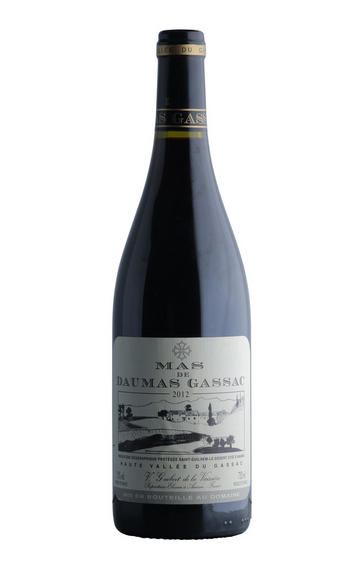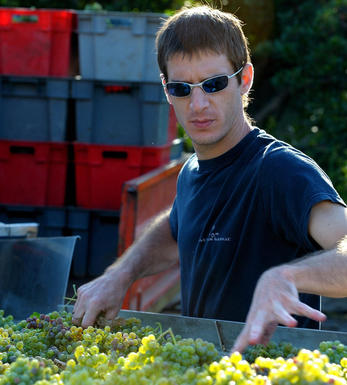
2012 Mas de Daumas Gassac, Rouge, Library Release, St Guilhem-le-Désert, Cité d’Aniane, Languedoc-Roussillon

Critics reviews
75.6% Cabernet Sauvignon, 5.5% Merlot, 4.4% Tannat, 3.9% Cabernet Franc, 1.8% Malbec, 1.8% Pinot Noir, 7% rare varieties.
This has become more meaty alongside the black fruit but also has become fragrant with a herbal garrigue scent. Still firm but more chalky than dense. Very dark-flavoured on the finish and rather closed for now.
Drink 2019 - 2027
Julia Harding MW, JancisRobinson.com (December 2017)
Like the 2013, this was not a notably ripe Mas de Daumas Gassac, but it's an outstanding vintage nonetheless, thanks to its aromatic finesse, complexity, and fine-sewn flavour contours. Black fruits are joined by raspberry, sweet tobacco leaf and fine leather. The concentration is impressive, and vibrant fruit-saturated acidity makes for a highly energetic, almost athletic style.
Drink 2018 - 2027
Andrew Jefford, Decanter.com (April 2018)
About this WINE

Mas de Daumas Gassac
Famously described as the ‘First Growth of the Languedoc’, Mas De Daumas Gassac remains unique in the region.
The world-famous red is an intriguing blend of Cabernet Sauvignon along with a mix of indigenous and more unusual varieties from the south of France, such as Grenache, Cinsualt and Tempranillo. Mas De Daumas Gassac Blanc is a similarly fascinating blend of grape varieties, with Chardonnay and Viognier taking centre stage. Lauded across the wine world, not for nothing is this Domaine named the Lafite of the Languedoc.

Languedoc-Roussillon
Over the last 25 years, the fortunes of Languedoc-Rousillon have been transformed largely due to the introduction of the Vin de Pays classification in 1979. This led to extensive replanting on more suitable sites, a drastic reduction in permitted yields and, crucially, reducing the dependence of red wines on the ubiquitous Carignan grape.
The new classification enabled producers not only to experiment with other grape varieties, but also to pick up the gauntlet thrown down by the New World – to give the customers what they wanted, namely clearly-labelled international varietals like Chardonnay and Cabernet Sauvignon.
Despite a sometimes deserved reputation for its contributions to the European wine lake, this exciting region continues to see a flow of investment from the Bordelais and others, which has enabled the evolution of the qualitative pyramid to continue. Perhaps the most striking improvements have been seen in Minervois La Livinière and Pic Saint Loup, but not far behind are the wines of St.Chinian and Cabardès.
Regardless of the financial influx and the wonderful terroir of the different appellations, the increase in quality is also allied to some extraordinarily-gifted winemakers, including Jean-Luc Terrier and Jean-Louis Denois.

Cabernet Sauvignon Blend
Cabernet Sauvignon lends itself particularly well in blends with Merlot. This is actually the archetypal Bordeaux blend, though in different proportions in the sub-regions and sometimes topped up with Cabernet Franc, Malbec, and Petit Verdot.
In the Médoc and Graves the percentage of Cabernet Sauvignon in the blend can range from 95% (Mouton-Rothschild) to as low as 40%. It is particularly suited to the dry, warm, free- draining, gravel-rich soils and is responsible for the redolent cassis characteristics as well as the depth of colour, tannic structure and pronounced acidity of Médoc wines. However 100% Cabernet Sauvignon wines can be slightly hollow-tasting in the middle palate and Merlot with its generous, fleshy fruit flavours acts as a perfect foil by filling in this cavity.
In St-Emilion and Pomerol, the blends are Merlot dominated as Cabernet Sauvignon can struggle to ripen there - when it is included, it adds structure and body to the wine. Sassicaia is the most famous Bordeaux blend in Italy and has spawned many imitations, whereby the blend is now firmly established in the New World and particularly in California and Australia.


Buying options
Add to wishlist
Description
75.6% Cabernet Sauvignon, 5.5% Merlot, 4.4% Tannat, 3.9% Cabernet Franc, 1.8% Malbec, 1.8% Pinot Noir, 7% rare varieties.
This has become more meaty alongside the black fruit but also has become fragrant with a herbal garrigue scent. Still firm but more chalky than dense. Very dark-flavoured on the finish and rather closed for now.
Drink 2019 - 2027
Julia Harding MW, JancisRobinson.com (December 2017)
wine at a glance
Delivery and quality guarantee